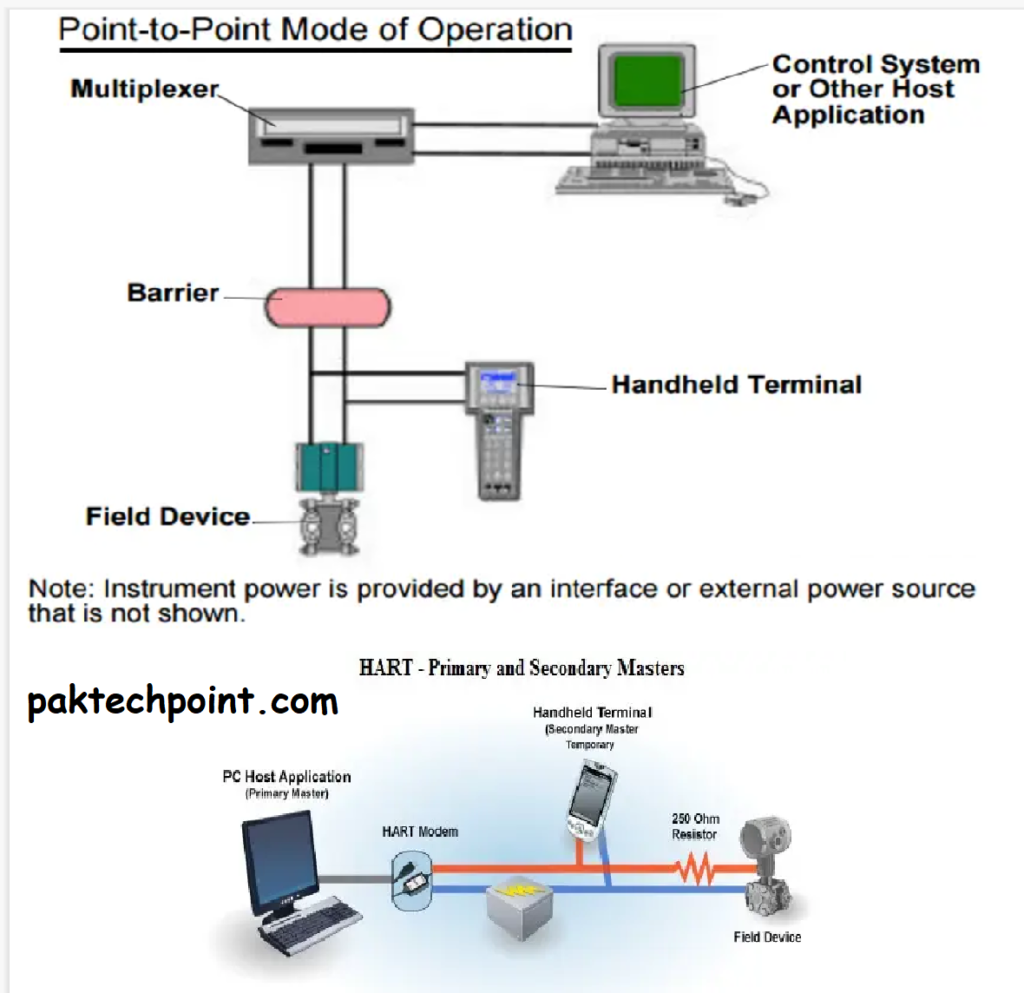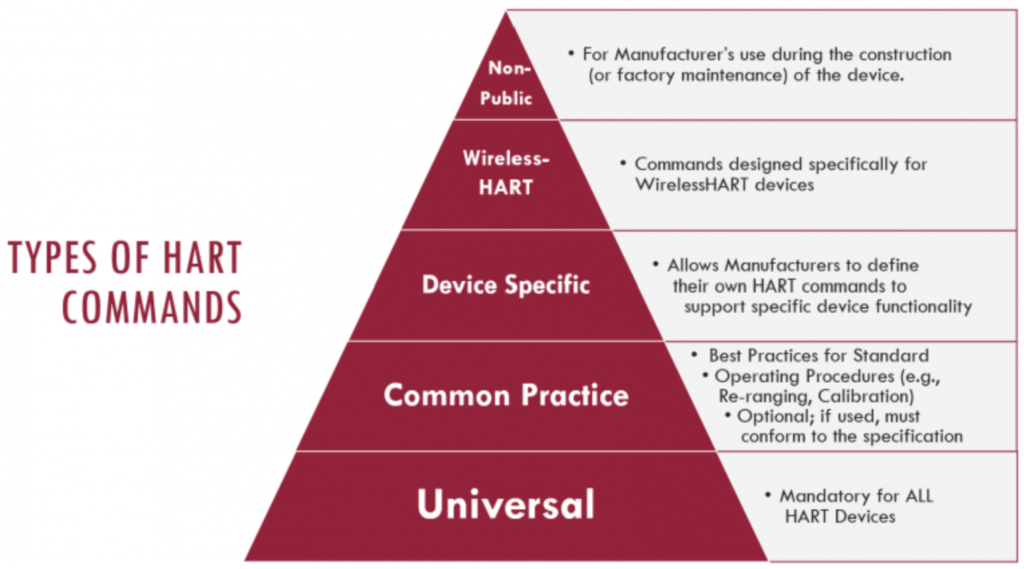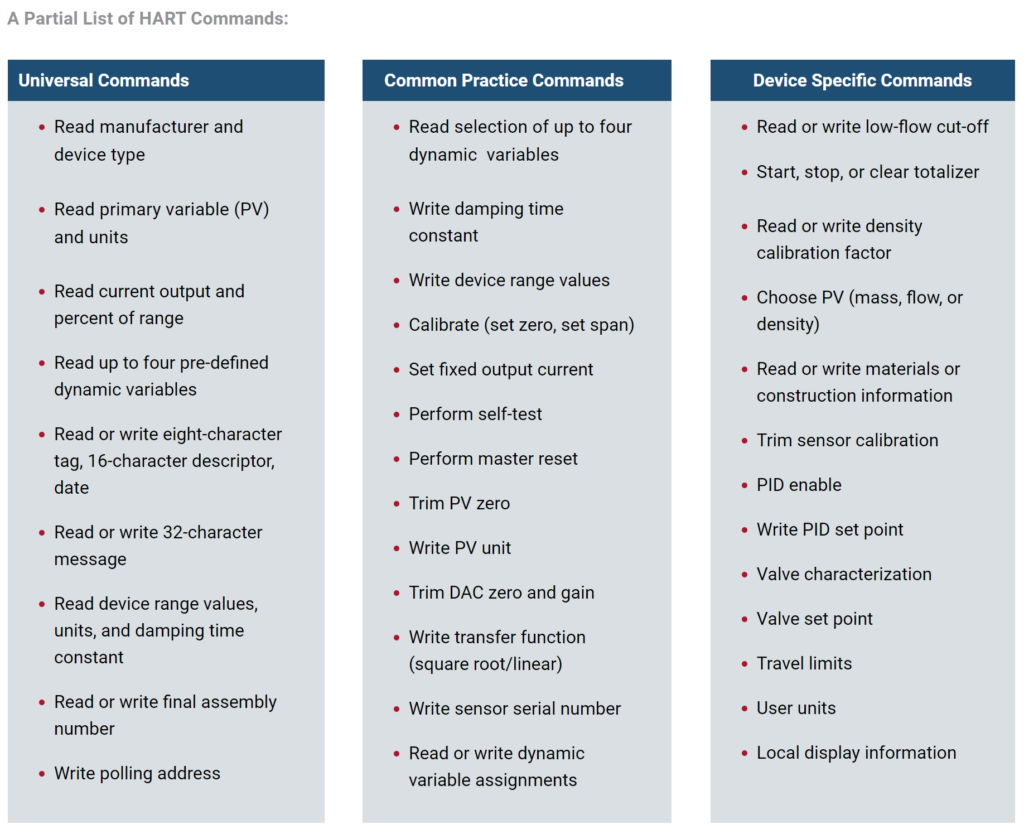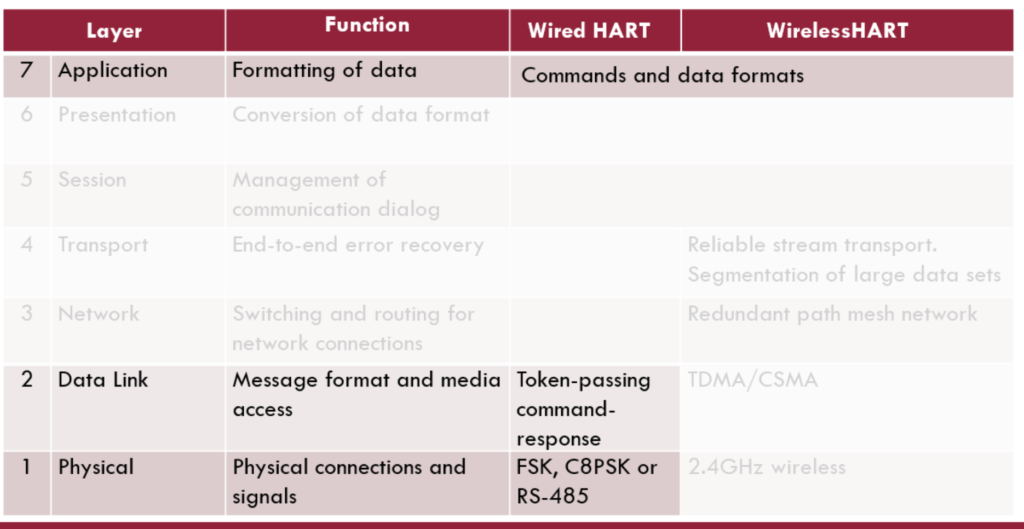In the vast area of industrial automation and communication, the HART Protocol stands tall as a versatile and widely-used communication standard. From enhancing process control to optimizing efficiency, HART Protocol has proven its worth in various industries.

In this comprehensive article, we go through the fundamentals of HART Protocol, its architecture, specifications, and how it compares to other popular communication protocols like MODBUS and 4-20mA Current. Join us as we unravel the potential of HART Protocol and uncover the advantages it offers for seamless data exchange and smart decision-making in modern industrial settings.
What Actually HART Protocol is?
In the dynamic world of industrial automation, the HART Protocol has emerged as a game-changing communication standard. HART, which stands for Highway Addressable Remote Transducer, offers a unique solution by combining analog and digital technologies, allowing devices to communicate over the same wiring infrastructure.
This revolutionary protocol enables real-time data transmission, remote configuration, and diagnostics, opening up a realm of possibilities for process control and asset management. Join us as we dive into the intricacies of the HART Protocol, exploring its applications, benefits, and how it continues to shape the future of industrial communication.
The HART Protocol has become an indispensable tool in the world of industrial automation, enabling seamless communication between smart devices and control systems. As the global standard for transmitting digital data over analog wires, it facilitates real-time data access and remote configuration of intelligent field instruments.
Whether used with handheld communicators or integrated into sophisticated plant systems, HART’s bi-directional capabilities empower technicians and engineers to optimize process control, asset management, and safety. In this article, we will delve into the intricacies of the HART Protocol, exploring its advantages and applications, as well as its comparison with other communication technologies like MODBUS and 4-20mA current.
Why we use HART Communication Protocol instead of 4-20mA?
HART Acronym stands for Highway addressable remote transducer. Why we use HART Communication Protocol? In the measurement industry 4-20 mA standard is worldwide accepted but this standard has one drawback, this process one variable at a time. For the bidirectional communication, the solution is HART which is made by superimposing alternating signal on 4-20 mA standard signal.
HART Protocol Working Principle
The HART (Highway Addressable Remote Transducer) Protocol operates on a unique principle that allows digital communication to coexist with analog signals on the same communication line. It utilizes Frequency Shift Keying (FSK) to superimpose digital signals over the traditional analog 4-20mA current loop.
Here’s how the HART Protocol works:
- Dual Communication: HART communication is designed to work in parallel with the analog signal on the same two-wire loop. The analog 4-20mA current represents the primary process variable, while the HART digital signal rides on top of this current.
- Frequency Shift Keying (FSK): HART employs FSK modulation to encode digital information onto the 4-20mA analog signal. A low-level frequency (1,200 Hz) represents a binary “0,” and a high-level frequency (2,200 Hz) represents a binary “1.”
- Coexistence: HART devices, such as smart field instruments, continuously transmit the primary process variable through the 4-20mA analog signal. Simultaneously, they embed additional digital information, such as measurement data, diagnostics, and configuration parameters, into the FSK-modulated signal.
- Master-Slave Relationship: The HART communication operates in a master-slave relationship. The host system (e.g., DCS, PLC, or handheld communicator) acts as the master, initiating the communication with the HART-enabled devices (slaves). The master polls the devices, and the devices respond with the requested information.
- Compatibility: The coexistence of analog and digital signals ensures backward compatibility. Traditional analog devices can work alongside HART-enabled devices on the same loop, allowing for a smooth transition from conventional to advanced smart instrumentation.
Overall, the HART Protocol’s ingenious working principle enables seamless integration of digital intelligence into existing analog systems, providing enhanced process monitoring, diagnostics, and control capabilities in industrial applications.

Read Also: WHAT ARE HART TRANSMITTERS PRNCIPLES
APPLICATION OF HART COMMUNICATION PROTOCOL
Sometimes it is also called hybrid Protocol because it combines the analogue and digital communication.
HART Protocol Networks
HART networks can be set up in either point-to-point or multidrop configurations.
In point-to-point mode, the traditional 4-20 mA signal is used for transmitting one process variable, while the HART protocol enables the transfer of additional data such as configuration parameters and device information (Figure 2). The 4-20 mA analog signal remains unaffected, allowing for normal control operations. The HART communication provides access to secondary variables for commissioning, maintenance, and diagnostics purposes. The protocol supports up to two masters (primary and secondary), allowing for the use of handheld communicators without interfering with the primary master.

The multidrop configuration, on the other hand, involves a single pair of wires connecting multiple field devices. Safety barriers and an auxiliary power supply may be required for up to 15 field devices. All process values are transmitted digitally, and devices are assigned polling addresses greater than zero. The current through each device is fixed at a minimum value (usually 4 mA) in multidrop mode. There is also an optional “burst” communication mode for continuous broadcasting of standard HART reply messages, which enables higher update rates in point-to-point configurations.

HART Protocol Block Diagram
HART Communication Modes
Communication Modes in HART Protocol are:
- Master-Slave Mode:
HART operates as a master-slave communication protocol, where each slave (field device) communication is initiated by a master communication device. A HART loop can accommodate two masters. The primary master is typically a distributed control system (DCS), programmable logic controller (PLC), or a personal computer (PC). The secondary master can be a handheld terminal or another PC. Slave devices, such as transmitters, actuators, and controllers, respond to commands from the primary or secondary master. - Burst Mode:
Certain HART devices support the optional burst communication mode, which allows for faster communication with data updates occurring at a rate of 3-4 times per second. In this mode, the master instructs the slave device to continuously broadcast a standard HART reply message, providing information like the value of the process variable. The master receives the message at the increased rate until it instructs the slave to stop bursting.
Specifications of HART Protocol
The HART Protocol, established in the late 1980s and currently at revision 7.3, is a widely-used standard for digital communication between smart devices and control systems. It has undergone updates while ensuring compatibility with previous versions.
At its core, the HART Protocol implements layers 1, 2, 3, 4, and 7 of the OSI 7-layer protocol model. The Physical Layer operates based on the Bell 202 standard and utilizes frequency shift keying (FSK) to achieve communication at 1200 bps. This FSK signal is cleverly superimposed on the 4-20mA analog signal, allowing simultaneous transmission without interference.
The Data Link Layer of HART defines a master-slave protocol, where field devices respond only when addressed by a master. This enables efficient communication with multiple devices on a single multidrop cable pair. The Network Layer handles routing, security, and transport services, ensuring secure and reliable end-to-end communication.
Within the Application Layer, HART defines different types of commands tailored to specific needs. These include Universal Commands, which must be implemented in all devices, Common Practice Commands shared by many devices, Device Specific Commands unique to certain devices as specified by the manufacturer, and Device Family Commands offering standardized functions for specific measurement types. The Protocol’s versatility and compatibility make it a valuable asset in modern industrial communication systems.
HART Commands:
HART Commands:
The HART Protocol follows a request-response communication approach, where each communication is initiated by a command from the host device, which can be a distributed control system, PLC, or PC-based asset management system. The field measurement device, such as pressure, level, temperature, or flow transmitters, responds to these commands.

To ensure proper communication and consistent responses, the HART Specifications define a set of commands that must be implemented in all HART registered devices. Users do not need to worry about these commands, as they are included in the functions of the host. Specific device capabilities are available to the host through Device Description (DD) instructions for each device.
Each communication response to the host includes defined device status indications, allowing the host to interpret these indicators and provide basic device diagnostic information.
The HART Command Set includes three classes: Universal commands that all devices must support for normal operations, Common Practice commands implemented by many HART devices, and Device Specific commands unique to each field device, providing access to setup, calibration, and construction information. Information on Device Specific commands is available from device manufacturers.

HART Protocol Layers
The HART Protocol follows the Open System Interconnection (OSI) 7-layer protocol model and implements several layers to facilitate communication between devices. These layers are:
- Physical Layer: The physical layer deals with the electrical and mechanical characteristics of the communication interface. In HART, the physical layer is based on the Bell 202 standard and uses frequency shift keying (FSK) to transmit data at 1200 bps. The HART signal is superimposed on the 4-20mA analog signal without interference.
- Data Link Layer: The data link layer defines the rules for reliable communication between devices over the physical layer. It establishes a master-slave protocol, where a field device (slave) only responds when spoken to by a master device. Up to two masters can connect to a single HART loop, enabling communication with handheld communicators and control systems.
- Network Layer: The network layer provides routing, end-to-end security, and transport services. It manages communication sessions between correspondent devices.
- Transport Layer: The transport layer ensures successful data transmission from one device to another, ensuring end-to-end communication.
- Application Layer: The application layer defines the commands, responses, data types, and status reporting supported by the HART Protocol. It categorizes commands into Universal, Common Practice, Device Specific, and Device Family commands, providing access to various device functionalities and information.

By implementing these layers, the HART Protocol enables seamless and efficient communication between intelligent field instruments and host systems, allowing for data access, control, and diagnostics in industrial processes.
HART Protocol Vs Modbus
| HART Protocol | Modbus |
| HART is a hybrid communication protocol that uses both analog (4-20mA) and digital communication. It superimposes digital data on the analog signal, allowing for bi-directional communication between smart field devices and control systems. | Modbus is a purely digital communication protocol based on a master-slave architecture. It uses a simple and lightweight message structure to communicate between a master device (such as a PLC or computer) and multiple slave devices (sensors, actuators, etc.). |
| Transmission Medium: HART uses a 4-20mA analog signal for transmitting process variable data, along with digital communication for additional information. | Transmission Medium: Modbus is typically used over RS-485 (Modbus RTU) or Ethernet (Modbus TCP/IP) for digital communication between devices. |
| Data Speed and Throughput: HART operates at a lower data speed compared to Modbus, typically around 1200 bps (bits per second). | Data Speed and Throughput: Modbus can operate at higher data speeds, depending on the transmission medium, reaching up to 115.2 kbps for Modbus RTU over RS-485 and even higher for Modbus TCP/IP over Ethernet. |
| Command Structure: HART has a defined set of universal, common practice, and device-specific commands for accessing device information and configuration data. | Command Structure: Modbus uses simple read and write commands for data exchange between the master and slave devices. |
Applications of HART Communication Protocol
Above is the simple example of HART Communication device. In this HART Devices like Handheld terminal and PC Host send request to the field devices for information for the prediction, monitoring and diagnostics the process. Meanwhile 4-20 mA standard signal is running without disturbance and distortion with digital signals.
This devices are used in many industries i.e. Petroleum & gas industry, chemical industry and cement industry.
HART Protocol Advantages
HART (Highway Addressable Remote Transducer) Protocol offers several advantages in the field of industrial automation and process control:
- Bi-Directional Communication: HART provides bi-directional communication over the same 4-20mA analog signal used for transmitting process variables. This allows both analog measurement data and digital information, such as device diagnostics and configuration parameters, to be transmitted simultaneously, enhancing data accessibility.
- Compatibility and Retrofitting: HART is designed to be backward compatible with existing 4-20mA analog systems. It can be easily integrated into traditional 4-20mA loops without requiring significant changes or additional wiring. This allows for the cost-effective retrofitting of smart capabilities to existing equipment.
- Remote Device Configuration: HART enables remote configuration and calibration of field devices. With HART-enabled devices, technicians can access and modify device settings from a central control system or handheld communicator without physically accessing the device in the field.
- Device Diagnostics and Maintenance: HART supports comprehensive device diagnostics, allowing for proactive maintenance and troubleshooting. Remote access to diagnostic data helps identify potential issues, reducing downtime and improving overall system reliability.
FAQs about HART Protocol
What is Frequency Shift Keying (FSK) in HART?
What are primary and secondary hosts in HART protocol?
What is Request-Reply Protocol in HART?
What are two types messaging in HART?
Analog 4-20mA Current Signal: This is the primary analog signal used for transmitting process variable data from the field device to the control system. The 4mA represents the lower range limit, and the 20mA represents the upper range limit of the process variable being measured.
Digital HART Communication: This is the secondary digital communication that is superimposed on the 4-20mA analog signal. It allows bi-directional communication between the field device and the control system, enabling access to additional process information, configuration data, diagnostics, and other device parameters.